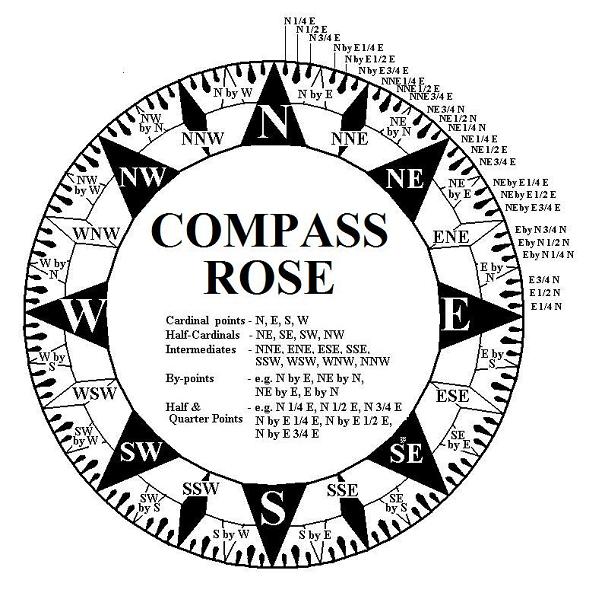Wind direction specifies the direction that the wind is blowing from.

128-point compass rose from http://www.naval-history.net/Oxon01-ShipList.htm
The half and quarter points have two equivalent names: N1/4E is the same as NxE3/4N.
The official US Navy nomenclature for all 128 points is given in Bowditch's American practical navigator.
When transcribing half, quarter, and eighth points, keep the number as a fraction rather than converting it to a decimal number.
In later years, the by-points seem to have provided sufficient resolution.
The by-point north by east is generally abbreviated as NbyE, NxE, or NbE.
Note that there is a significant difference between NE, which is 45 degrees, and NbyE, which is 11.25 degrees.
By the mid 1900s, wind direction was generally expressed in degrees (e.g., USS Burton Island 1947)
For more details, see Points of the compass.
Other wind direction column entries include:
- Calm and Lt Airs
- Var, Variable, Various
- Nly, Ely, Sly, and Wly for Northerly, Easterly, Southerly, and Westerly
They may include an apostrophe e.g., N'ly - Nd, Ed (sometimes Eastd), Sd, and Wd for Northward (i.e. wind from the northward), Eastward, Southward, and Westward
They may include an apostrophe e.g., N'd - In older logs, and especially in whaling logs, you may find yourself baffled by 'baffling airs'.
Although the CLIWOC Multilingual Meteorological Dictionary (PDF) is primarily concerned with old terms for wind force, some of the terms listed apply to wind direction.
With the exception of the degree symbol, directions should be transcribed as they appear in the log.
Admittedly, this is often easier said than done!
If the direction is illegible, feel free to make your best guess or use a tilde (~) to indicate the letter(s) you cannot read.
Don't be shy about asking for help reading the wind direction in the forum.
Your ship's discussion topic is generally the best place to post these questions.
The degree symbol is an exception to the Type What You See rule.
Because our current transcribing system does not handle special characters, the degree symbol should be omitted.
N35oE should be transcribed as N35E.
If it is necessary for clarity, enter the word degree or degrees.
The minute and second symbols may also be omitted as long as the meaning is clear.